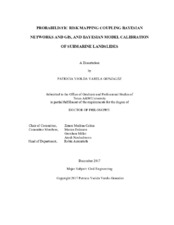| dc.description.abstract | A spatial and causal probabilistic methodology is introduced for risk assessment based
on the coupling of a conceptual Bayesian Network (BN) model and GIS to generate risk
maps. The proposed integration of these spatial events is referred to as BN+GIS, which
features forward and inverse modeling, denoted in this work as spatial prognosis and
spatial diagnosis, respectively. This approach is illustrated through two case studies: (1)
environmental risk associated to oil and gas site developments implemented in the
Barnett Shale Play in Texas, and (2) landslide susceptibility in the Elliott State Forest in
the Oregon Coastal Range. This approach will equip stakeholders, such as land owners,
operators, regulators, government officials, and other related organizations with a
platform that can help them improve the assessment of future potential risk scenarios,
and to identify likely consequences that would lead to undesirable states of environmental
risks ahead of time. A sensitivity analysis was performed on BN+GIS to study the
influence of some of the user-defined parameters on the model’s results, such as sample
size, spatial interval of the systematic sampling methodology, and the prescribed
diagnosis distribution used for decision making purposes. As an additional effort to
portray the potential application of the Bayesian paradigm on risk assessment, a
parameter estimation methodology is implemented using bathymetry data and CPT logs.
This approach is illustrated through a study case, where information was mined from
existent landslides to perform a Bayesian calibration on an infinite slope model. This
approach allowed to estimate posterior probability distributions of physical parameters
given a prescribed factor of safety, to assess the most likely depth of failure, and to
identify the optimum amount of samples required to maximize the reliability of the
inferences. This work focusses on providing a substantial contribution to improved
policymaking and management through the use of integrated sources of evidence such as
real data, model predictions and experts educated beliefs. | en |


